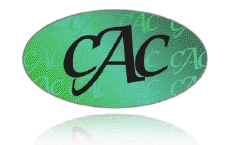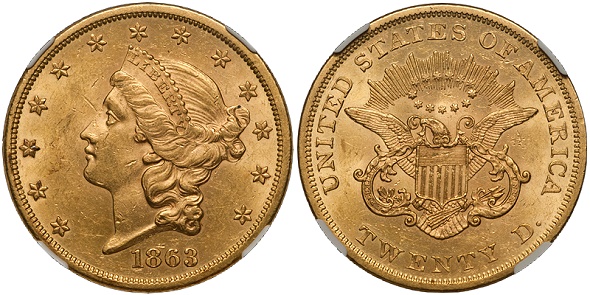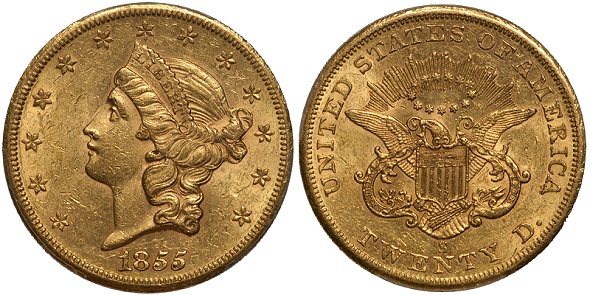By Doug Winter – RareGoldCoins.com
Certified Acceptance Corporation (CAC) has had a profound impact on the rare date gold market, and one of the series which has seen significant changes as a result of CAC is Type One Liberty Head double eagles.
 Auction results and private transactions for coins with CAC stickers, especially rare dates, show a strong price appreciation; sometimes as high as 40-50% for those coins with stickers. But this article isn’t a price analysis. I am more interested in focusing on the number of coins with CAC approval for each date and looking for “surprises” within the context of these numbers.
Auction results and private transactions for coins with CAC stickers, especially rare dates, show a strong price appreciation; sometimes as high as 40-50% for those coins with stickers. But this article isn’t a price analysis. I am more interested in focusing on the number of coins with CAC approval for each date and looking for “surprises” within the context of these numbers.
For the sake of convenience, we can divide the various Type One dates into three groups. The first bunch—or Group A—consists of coins with CAC populations of fewer than 10 in all grades. The second bunch—or Group B—consists of coins with CAC populations between 10 and 25 in all grades. The third and final bunch—Group C—consists of coins with populations of 25 or higher.
Let’s take a look at Group A.
|
RANK |
DATE |
TOTAL APPROVED BY CAC |
| 1. | 1854-O | 1 |
| 2. | 1860-O | 3 |
| 3. (tie) | 1856-O, 1862 | 4 |
| 5. (tie) | 1855-O, 1858-O, 1859 | 5 |
| 8. | 1859-O | 6 |
| 9. | 1861-S Paquet | 7 |
| 10. (tie) | 1861-O. 1866-S No Motto | 10 |

This first group contains some surprises. I wouldn’t have expected only three 1860-O double eagles to have been approved by CAC, and I certainly didn’t expect there to be one fewer of this date with CAC approval than for the celebrated 1856-O. I’ve handed two of the three CAC’d 1860-O double eagles and now that I realize how “special” these are, I wish I had asked a greater premium when I sold them!
I am surprised that only five 1858-O double eagles have been approved by CAC (none of these in higher grade) as I have personally handled some very nice About Uncirculated examples of this date. The rarity of the 1859 and 1862 Philadelphia issues doesn’t surprise me as these two dates tend to come bright and bagmarked; two things which do not score points with the finalizers at CAC. I am very surprised that seven 1861-S Paquets and ten 1866-S With Motto double eagles have been approved. If I had to venture a guess, I’d suggest that these numbers are inflated by resubmissions.
Now let’s look at Group B.
|
RANK |
DATE |
TOTAL APPROVED BY CAC |
| 1. (tie) | 1854 Lg. Dt., 1857-O | 12 |
| 3. | 1853/2 | 13 |
| 4. | 1854-S | 16 |
| 5. (tie) | 1858, 1863 | 18 |
| 6. | 1853-O | 20 |
| 7. | 1864 | 21 |
| 8. | 1855 | 22 |
I am surprised by a few dates on this list, both for how many have been approved and how many have not. In the former category, I find it odd that twelve 1857-O double eagles have been approved by CAC as compared to just five for the 1858-O. These two dates are very similar in rarity, both overall and in high grades. It is possible that this represents some resubmissions to CAC. I am also surprised that as many as twenty 1853-O double eagles have been approved as this is a date which, even in VF and EF grades, doesn’t tend to have the “look” that CAC favors.

The 1863 and 1864 are a bit less hard to locate with CAC stickers than I would have expected, but this is partially due to there being some nice higher grade examples from the S.S. Republic shipwreck.
The real surprise date in Group B is the 1858 with the same total number of coins approved by CAC as the much more pricey 1863. Only three Uncirculated 1858 double eagles have been approved by CAC and even About Uncirculated pieces are harder to locate than I would have expected.

The one date in Group B which deserves special mention is the 1854-S. Most of the CAC approved examples I have seen are from shipwrecks, and I doubt if more than three or four examples with original surfaces have been approved by CAC.
Let’s close out this article by looking at Group C.
|
RANK |
DATE |
TOTAL APPROVED BY CAC |
| 1. | 1856 | 29 |
| 2. | 1850-O | 29 |
| 3. | 1857 | 31 |
| 4. | 1861-S | 33 |
| 5. | 1852-O | 34 |
| 6. | 1860-S | 38 |
| 7. | 1864-S | 40 |
| 8. | 1858-S | 41 |
| 9. | 1863-S | 42 |
| 10. | 1854 Small Date | 43 |
| 11. | 1859-S | 47 |
| 11. (tie) | 1862-S | 47 |
| 11. (tie) | 1851 | 47 |
| 14. | 1851-O | 49 |
| 15. | 1860 | 55 |
| 16. | 1865-S | 62 |
| 17. (tie) | 1853, 1865 | 63 |
| 18. | 1855-S | 85 |
| 19. | 1852 | 88 |
| 20. | 1850 | 91 |
| 21. | 1856-S | 128 |
| 22. | 1861 | 163 |
| 23. | 1857-S | 515 |
In looking at Group C, I almost wonder if the cut-off list shouldn’t have been higher than 25 coins as the first few dates (1856, 1850-O, 1857, 1861-S and 1852-O) instinctively feel “scarcer” with CAC stickers than the other dates included in this group.
As you can see, Group C is populated by common dates and/or shipwreck issues and this is responsible, obviously, for higher CAC populations. The former category is best illustrated by the 1861 while the 1856-S and the 1857-S are the respective poster children for the latter.

The two shipwreck dates with lower CAC populations than I would have expected are the 1863-S and the 1864-S. Both issues have a number of higher grade survivors from the S.S. Brother Jonathan and the S.S. Republic and it surprises me that there aren’t at least twice as many examples for each date with CAC stickers.

The two dates in Group C that strike me as having higher CAC populations than I would have expected were the 1850-O and the 1855-S. I have handled numerous 1850-O double eagles and I’d say that no more than 10% of the ones I have owned have been CAC quality. The 1855-S is one of the most frequently seen Type One issues with CAC approval. This is most likely due to shipwreck coins but I can’t recall having seen all that many non-shipwreck pieces with CAC stickers.
One of the many things that CAC has done for the Type One market is to get collectors better focused on choice, original coins. The price premiums for the low population Group A coins have, in some cases, greatly exceeded the levels for “typical” coins and this is the case in nearly all grade ranges. The price premiums for the Group B and Group C are not as profound (yet) but as more collectors seek CAC approved coins, the premiums for these may increase to levels close to those seen on Group A dates.
About Doug Winter
 Doug has spent much of his life in the field of numismatics; beginning collecting coins at the age of seven, and by the time he was ten years old, buying and selling coins at conventions in the New York City area.
Doug has spent much of his life in the field of numismatics; beginning collecting coins at the age of seven, and by the time he was ten years old, buying and selling coins at conventions in the New York City area.
In 1989, he founded Douglas Winter Numismatics, and his firm specializes in buying and selling choice and rare United States coins, especially US gold coins and all branch mint material.
Recognized as one of the leading specialized numismatic firms, Doug is an award winning author of over a dozen numismatic books and the recognized expert on US Gold. His knowledge and exceptional eye for properly graded and original coins has made him one of the most respected figures in the numismatic community and a sought after dealer by collectors and investors looking for professional personalized service, a select inventory of impeccable quality and fair and honest pricing. Doug is also a major buyer of all US coins and is always looking to purchase collections both large and small. He can be reached at 214-675-9897.
Doug has been a contributor to the Guidebook of United States Coins (also known as the “Redbook”) since 1983, Walter Breen’s Encyclopedia of United States and Colonial Coins, Q. David Bowers’ Encyclopedia of United States Silver Dollars and Andrew Pollock’s United States Pattern and Related Issues
In addition he has authored 13 books on US Gold coins including:
- Gold Coins of the New Orleans Mint: 1839-1909
- Gold Coins of the Carson City Mint: 1870 – 1893
- Gold Coins of the Charlotte Mint: 1838-1861
- Gold Coins of the Dahlonega Mint 1838-1861
- The United States $3 Gold Pieces 1854-1889
- Carson City Gold Coinage 1870-1893: A Rarity and Condition Census Update
- An Insider’s Guide to Collecting Type One Double Eagles
- The Connoisseur’s Guide to United States Gold Coins
- A Collector’s Guide To Indian Head Quarter Eagles
- The Acadiana Collection of New Orleans Coinage
- Type Three Double Eagles, 1877-1907: A Numismatic History and Analysis
- Gold Coins of the Dahlonega Mint, 1838-1861: A Numismatic History and Analysis
- Type Two Double Eagles, 1866-1876: A Numismatic History and Analysis
Finally Doug is a member of virtually every major numismatic organization, professional trade group and major coin association in the US.
If you are interested in buying or selling classic US coins or if you would like to have the world’s leading expert work with you assembling a set of coins? Contact Doug Winter at (214) 675-9897 or by email at [email protected].




